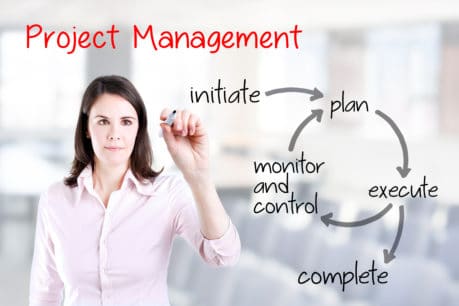Streamlining the manufacturing process requires reducing complexity. This is not an easy task; success involves strategic analysis, planning, and implementation. Efforts to simplify operations should be orchestrated for reduction of complexity without sacrificing performance or compromising customer requirements.
The most profitable ETO companies generally follow three fundamental steps in approaching new projects in order to avoid wasted time and effort. Wherever plans seem overly complicated, a breakdown of steps and focus on achieving milestones is important to streamlining the workflow.
1. Project Initiation
This involves defining the project in terms of scope. leadership, and progress milestones.
Project Scope
When the customer goal has been identified and accepted, projects usually being with a high-level charter. This defines the scope of the work that will be done. Is is building a new warehouse? Relocating a data center? Or a new power tool prototype? What exactly is involved? If the goal is to design a custom irrigation system, is updating or replacing the water main part of the project? Steps and details in the actual manufacturing process will be covered in the planning phase.
The charter should clearly word the desired outcome and timeframe, as well as objective terms essential to the process. Establishing how a project is to be judged “successful” or “failed” should be unequivocally stated, not colored with subjective terms such as “improved” or “superior”. Ambiguous language leaves too much room for interpretation.
Project Manager
Some individual must take on a leadership role and responsibility for project management. In many ETO environments this is a professional project manager, or at the least some person with the most experience and expertise related to the nature of the project. At times it may be necessary to have two or even more project co-managers to get the requisite knowledge and skills. In some companies, there will be project teams that already have these attributes and experience; then it’s only necessary to have a project manager who brings communication and organizational skills to the leadership role to best align efforts and resources.
Milestones
Milestones are achievements that mark the successful completion of critical phases in the development of the project. These could be seen as mini-goals or fabricated segments that must be met before the next phase of operations begins. Simple projects may have only one or two, or even no milestones, while more complex projects may have many.
For instance, in designing a new electric car, there might be the body styling, interior, dashboard, features, and a string of technical challenges, often pursued by different teams, with several milestones in each area. Milestones often involve obtaining client or executive approval before they can be considered complete and work can move on to the next milestone.
2. Project Planning
Most of the impact on project management comes from the planning phase. A project plan is a set of documents that detail steps for achieving each milestone identified in the project scope. The project plan is also important for risk analysis, material scheduling, and defining governance procedures. The following are all elements to include in the project plan:
* WBS: The Work Breakdown Structure is essentially a list of all the smaller elements that are necessary to project success. The WBS should cover all of the deliverables defined in the project scope. The WBS should not be seen in terms of tasks, but building blocks to achieve the final outcome.
* Estimates: This is the process of listing out what’s needed by the WBS list, and what timeframes it will take to realize each element. This enables project managers to schedule available resources to workflow. Both optimistic and pessimistic estimates should be taken into account in case there is a need to change expectations.
* Sequence: It’s essential to determine the order in which each deliverable should be completed. GANTT charts are often used to illustrate this. While there may be some leeway on a satisfactory order of tasks, orderly progress is important to scheduling and workflow.
* Risks: Consideration of possible risks that could derail progress is also important. Team members and leaders can find a time to brainstorm over all the things that might go wrong and how they can be prevented, as well as contingency plans if the worst does happen.
* Leveling: This is the plan for correlating the resources needed, including human, technological, and material sources, with the resources on hand, and how to compensate for any gaps in time to meet deadlines.
* Schedule of Implementation: This is final project schedule which bring together all the planning factors listed above into a series of steps with clearly established timeframes, resource management, and milestones.
* Communication: It’s also useful to establish communication protocols at this point. This could involve scheduling status meetings, reporting emergencies, communication channels such as text or email, or central data depositories.
Establishing and communicating an achievable plan is important to eliminate redundant or irrelevant work.
 3. Project Execution
3. Project Execution
From the moment the work begins, problems can occur. The project manager is responsible for adjusting to changes in scope, time frames, features, personnel, unexpected material loss, or a range of other scenarios to ensure project delivery. Contingency plans are put in place as project controls to see that no matter how the plan changes, each step is followed in progression as it was conceived.
Regular status updates are another way to maintain control. On a regular basis or as milestones are realized, team members report progress made or issues encountered to the project manager so that schedules can be re-calibrated and progress updates delivered to the key stakeholders.
Developing standard templates, deadlines for submission, and means of digital delivery may be a more effective way of submitting progress reports for analysis, especially with complex projects and large teams. Where there are multiple teams involved, the project manager may want to appoint team leaders to help in the information gathering and communication.
Project Completion
When all of steps have been followed to success, and any testing or final client approval has taken place, the project may be closed. But it isn’t enough to simply sign off and file away the documentation as the next project takes shape. Ensuring positive results and continuous improvement from project management involves post-completion analysis for refining protocols and improving workflow on future projects.
A project summary should be written and discussed with team members and executive stakeholders. It should not be too complicated or time consuming; one or two sessions and some feedback or Q&A from team members should be enough to obtain some benefits for all concerned.
The summary should include the following:
* Factors in the success of failure of completing each milestone on time.
* Why changes were made in project scope and how they were dealt with.
* Variation between planned and actual resources, such as waste, budget overruns, and substitutions.
* The project’s impact on both the organization and the client.
* Lessons/suggestions that could translate to continuous improvement in future projects.
Reducing complexity of processes while drafting and sticking to an orderly plan is often a difficult juggling act, but essential to improved efficiency. It’s important to create plans for simple or complex projects in terms of systematic growth from concept and design to resource schedules and project delivery. It’s essentially a very simple process that should be well-thought out and well-documented, but never needlessly complicated.

 3. Project Execution
3. Project Execution




